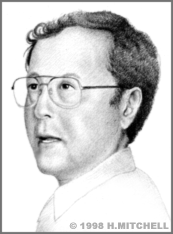Toyoichi Tanaka
Born and raised in Japan, Toyoichi Tanaka received his higher education at the University of Tokyo, where he earned a BS (1968), MS (1970), and DSc (1973), in Physics. In 1975, he joined the faculty at the Massachusetts Institute of Technology, where he rose to the rank of Professor of Physics as well as Morningstar Professor of Science.
Tanaka’s field of expertise was gels. A gel is typically a mixture of a polymer “matrix,” that is, a chain of individual molecules, and a fluid “solute,” in a ratio of about 1:30. The obvious example is Jell-O®, which has a matrix of gelatin in a solute of sugar water. However, synthetic gels can be made in which the polymers are very tightly bonded---with sometimes surprising results.
In the mid-1970s, Tanaka discovered that certain synthetic (polyacrylamide) gels had remarkable properties: for example, they responded to minute changes in their environment by drastically swelling up or changing color. Any substance will respond to its environment to some extent; but Tanaka learned to fine-tune his gels to undergo radical changes, or “phase transitions,” when they encounter either a chemical or a change in conditions (temperature, light, electricity, magnetism, etc.).
Tanaka’s gels have valuable applications because they can expand and contract up to 1,000 times their original volume in response to predictable stimuli: for example, these gels could be used as artificial muscles, set in motion by a specific electrical pulse. More importantly, the polymers in the gels can capture or expel specific substances as they grow or shrink, so that the gels could be used, for example, as super-sponges to absorb and immobilize toxic waste, or as molecular filters of various sorts.
The more complex stage of Tanaka’s research was to develop “smart” gels, which imitate proteins by recognizing conditions and responding to their environment. For example, smart gels can be fine-tuned to draw humidity from the air when it is over a given temperature, or even to release insulin when the glucose level around them drops below a given point.
By 1992, Tanaka had earned eight patents for his gels. In the same year, he and a partner founded GelMed, Inc., in order to market SmartGel® products. Their first effort was a liner for shoes and skates, which is pliant until it encounters the body heat of the foot; then it firms up to provide custom-molded support. The firm focused on medical applications of the gels, such as long-lasting eyedrops and sunscreen; and numerous drug delivery systems are in production.
Tanaka’s many awards include the Inoue Prize in 1994, which is awarded to a scientist under age 50 for outstanding achievements in basic sciences, and the Award of the Polymer Society of Japan in 1986. He received an award for newly-emerging technologies from Discover magazine in 1996 and became a fellow on the American Physical Society in 1992.
Tanaka died of heart failure in 2000 at the age of 54.


